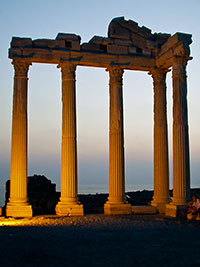Side, set on Turkey's sparkling Mediterranean Coast, is an important archaeological site that has developed into a major holiday resort and popular vacation destination.
When I first visited Side in 1982, it was a small sleepy Turkish fishing village with a small fishing harbour and some tourist shops. The past 20 years Side has known a startling transformation from a fishing village to one of Turkey's most popular vacation destinations. Tourism is now big business in Side and in the summer season, this holiday resort and the adjacent luxury hotels are filled with package tourists that come to Side for the long wide sandy beaches next to the remnants of antiquity. However, Side still retains its charm and it is unique in Turkey as a living open-air museum in a spectacular setting.
History of Side
The name Side probably means pomegranate in some ancient Anatolian language. The site was colonized by Aeolians, a Greek people, at about 600 BC. With a population of 60,000, it was the largest, richest port in Pamphylia. When Alexander the Great captured the city in 333 BCE its people spoke a language unknown to the invaders and it is still not deciphered. Initially, Side's wealth was based on slave trade and piracy, which flourished under the Greeks. These practices stopped when the city came under Roman control. Under the Byzantines, Side was important enough to have its own bishop. In the 7th century AD, Arab raids diminished the town which was finally abandoned after earthquakes in 1150. In the 19th century, Muslims from Crete settled in Side.
Sights & Photos of Side
The site of Side's temples of Apollo and Athena is perhaps the most romantic and moving antique monument of Anatolia. These structures date back from the 2nd century CE and are located at the southwestern tip of Side's harbour. The temple of Apollo has partly been reerected and has become Side's trademark. Side's marina is a popular anchoring place for yachts. In addition, the fine sandy beaches make it a top beach holiday destination. The colourful inner town with its ancient ruins and tourist shops is effectively pedestrianized and transportation for those opposing a walk is done by a Disney-like little train.
Let's make a pictorial tour through Side's open-air museum. After entering the archaeological site from the city centre, the first major archaeological remains are the ruins of the Government or State Agora, which was built in the 2nd century CE. This square structure has a length of 88.5 m and a width of 69.2 m and was famous as an important slave market. It was on all sides surrounded by porticoes. The next remains are those of a Byzantine hospital or guesthouse which was built in the 6th century CE. Originally, the building consisted of 2 stories with a total of 24 rooms and served both as a guesthouse and as a hospital. The next encounter is formed by the ruins of Byzantine basilica, which is the second basilica of Side and was constructed in the 5th century CE.
Side's spectacular theatre is the largest in Pamphylia and provided seats for over 15,000 spectators. It was built in the 2nd century CE and is a freestanding structure, not built into a hillside. The next encounter on our walk through Side's ruins are some Roman shops, near a collonaded street. After some unidentified ruins are the remains of the Nymphaeum. This fountain was built in the city walls in the 2nd century CE. It consists of three semi-circular parts, carved into the wall. The water was carried by lead pipes to the fountain. The Side Nymphaeum is the most outstanding fountain in the whole Anatolian region and a close copy was made in Italy by Emperor Septimus Severus. A collonaded street leads further to Side's main street and Monumental Gate with another theatre.
https://www.turkeyphotoguide.com/side?tmpl=component&print=1&page=#sigProId25f4525ed9
Travel Information & Travel Tips
We visited Side during our 2004 tour of Turkey's Mediterranean coast and stayed for one night in Hotel Lale Park, Lale Caddesi Tel. +90 (0)242 753 1131), which had a very friendly manager.

































